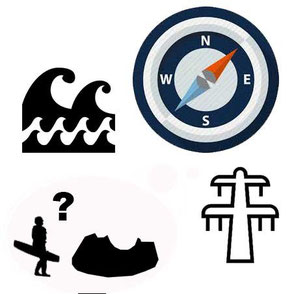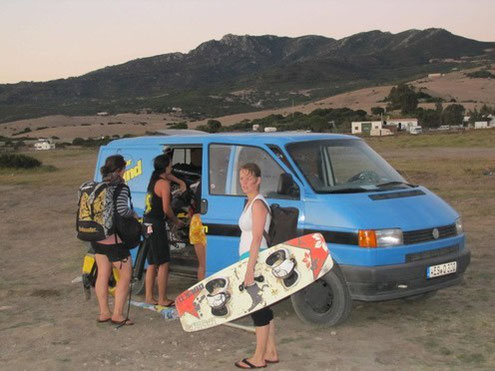So you want to learn to Kitesurf and you’ve chosen Tarifa as the place to do it. Great.. you have chosen well; Tarifa is a fantastic place with a lovely vibe and really is the wind capital of Europe.
Now all you need to do is choose a kite school and you're set to become a true legend with a kite!
But hang on a moment......
If you're new to kitesurfing... Just what do you need to know when it comes to choosing a kite school and booking your lessons to make sure you're not one of “those” people who fail to get past the water start.
Fortunately you just need to know a few key points and we have listed them for you in this blog post.
Follow these points before booking your classes and you will end up with a great value and successful learning experience.
Enjoy
Here are the 9 key things you need to know before booking your kite lessons so you can choose the right school for you.
- Don’t get sold on being put into a large group.
- Is your instructor qualified to teach, IKO, VDWS, BKSA, FAV etc
- How do you know the conditions are right to learn to Kitesurf?
- Camps or pay as you go. What's Best?
- No wind no pay.
- Transfers to the beach
- Why Licensed schools?
- Languages - Make sure your instructors speaks your language
- IKO registered courses why that matters.
#1 - Don't get sold on being put into a large group
And here’s why!
- Learning to kitesurf in a group means one instructor shared amongst the members of the group.
- The larger the group, the less time you actually get with the instructor
- The larger the group, the more chance you have that someone is slower than you.
- Time on the kite - If you are having to share a kite with more than 1 other person you are going to be having to do a lot of waiting around.
- Safety - 1 instructor for say 6 or 8 people with somewhere between 2 and 4 kites. When learning to kite you really want your instructor as close as possible. Because:
- If you get into trouble and your instructor is focusing on someone else. Who takes care of you?
- If they then have to come from a distance to reach you on the beach or in the water this is even worse.
In peak season the beaches can get very busy, now that's fine if you're confident with a kite. However if you're a beginner and you get out of control, things can get bad very quickly. So its critical for yours and everyone's safety that you are well supervised and the instructor is close by.


But what does all that really mean to you?
So here you are in your first class, you pick up the kite and you’re doing really well, however you're in a group of say, 8.
This means that you have to wait for the other 7 people to practice the skill you have just mastered.
On top of that, some of the others are just not making the same progress that you are, which means that the whole class will only progress at the rate of the slowest person. Argh…...
Now imagine this across the 7 days of your holiday.
How much time will actually spend learning vs waiting on the beach? ….
And waiting time, is time you are not learning and not progressing and lets not forget that you were actually paying for this by the hour.
So what the best way to learn to kitesurf?
Don’t get me wrong group course do work, BUT, only if they are small. 4 people in a group with one instructor and two kites is the maximum that you should consider. It brings a good balance of time with the kite, time with your instructor for support and guidance.
And of course a cost effectiveness that's hard to beat. So if you are on a budget to learn how to kitesurf this is probably the best option.
Other options?

Semi private lessons - which may appear be a bit more costly, but definitely worth it.
-
You get one instructor for two students
-
Get to spend more time with the kite
-
The learning experience is much more personal.
-
Allows the instructor to really push you to achieve your best.
-
You will also be matched to someone who learns at a similar rate to you.
(As a kite school in Tarifa these have been our most popular courses in the last 5 years).

Private classes - One on one kitesurfing tuition and coaching, really is the best way to learn, although it’s the most expensive option.
Having said that, you have your instructors full attention for the duration of your course and their sole focus is to get you achieve your goal.
#2 - Is your instructor qualified to teach?

It might seem obvious but if you don’t know the school you should ask the question. Organizations such as the IKO (International kitesurfing Organization), the VDWS (Verein deutscher Wassersportler), the FAV (Federacion Andaluza de Vela) and the BKSA (British Kitesports Association) have created training courses to ensure that instructors are suitable teachers.
The goal being to ensure each student achieves the learning objectives of the class and re-enforces the safety principles that must be learnt to make sure you are a good and safe kiter. Both in your learning environment and in the future when you have reached independence.
#3 - How do you know the conditions are right to learn?

To Kitesurf you need the right wind conditions and for learning this is especially true.
As a beginner you should only be going out in suitable conditions and sadly the wind does not work on a “schedule” so its almost impossible to know other than on the day, exactly what time and where the wind will be right for teaching.
I know… it might sound strange to hear… Where the right wind will be!!!
This is Tarifa we are talking about; it's the wind capital of Europe. However the reality is the wind moves around a lot and you don’t want to be in the wrong place at the wrong time.
- Too strong and you’re going to be blown all over the place, if you’re not competent with the kite this can be very dangerous.
- Too light and you’re going to really struggle to learn and make the progress.
Why would a school take you out in conditions that are not ideal?
Quite simply; money!
If a school has two classes booked per day and limited number of instructors, they can’t move classes with the wind.
So the only options are:
-
Postpone classes for another time and turn away the money
-
Take people to the beach even if they are not going to learn much
If you out in the wrong conditions you won't be getting a good learning experience and when paying by the hour the only winner in this situation is the kite school.
#4 - Camps or pay as you go?

There are generally 2 options when it comes to taking courses:
- A week long kite camp
- Sign up for a fixed hours / days course
Camps
If done correctly camps are great, everything should be taken care of (Accommodation, 2 meals a day, transfers to the beach and tuition) so you can just arrive in Tarifa and enjoy your holiday.
Generally you will be with a group of like minded people, so camps can also be quite a lot of fun.
However the challenge comes if the conditions are not ideal. What do you do then?
If you are choosing a camp make sure the school provides options if the conditions are not suitable for kiting.
For example if there is no wind here in Tarifa what else can you do. Now being the Atlantic coast there is a high possibility if there is no wind then there will be waves somewhere along the coast. So the question to ask is; does the camp operator offer additional activities such as guided surfing, SUP or even wakeboarding; at no additional cost.
“As it goes, these sports are conducive to learning the board riding element of kitesurfing, so are great things to practise when there is no wind.”
Clearly it's not the school's fault that the wind is not suitable for teaching, but in fairness this is your holiday and you shouldn’t expect to be left sitting around having to find and pay for something else to do.
#5 - No wind no pay
Kitesurfing Courses
Be it a 1 day taster session or a 14 day kite course, if you sign up for a course be wary of companies want all the money prepaid, make sure you are clear on the school's policy for refunding unused lesson time.
No wind no pay
The best policy for kiters is pay as you go, so no wind no pay and if you have paid in advance that you can get any outstanding hours refunded. And not just in vouchers for the school you are signed up to.
#6 - Transfers to the beach

Shockingly obvious but often missed..
We meet a lot of people who don't hire cars for their holiday and getting to and from the beach each day can be a real bind, if your kite school does not include the transfers for free.
TO put this into perspective the various kiting beaches range from the sports stadium, near the entrance of Tarifa through to Playa de Los lances (4K), Valdevaqueros (10K), Palmones (28k),Caños de Meca (58k) or even Conil (65k). And if you think taking a taxi would work, Los Lances is €10, each way......
So getting to your kite class needs transportation and make sure your transfers are included.
#7 - Licensed schools
Make sure you choose an official kiteschool.
Why?
This ensures that they have all the important licenses and insurances, they offer the sea angel boat rescue service and they should cover you for accidents when kiting with their insurance. If you don't have holiday insurance make sure your school does.
#8 - Does your instructors speak your language
The last thing you want is to be in a class with an instructor you struggle to understand so make sure you specify the
language you want to be taught in. English, German, Spanish, French, Arabic, Italian
#9 - IKO registered courses

IKO registered courses do matter for those who want to carry on kiting and renting material all over the world.
If you joined a school which has licensed instructors or is affiliated to one of the big kiteboarding associations like IKO, they should offer you a free IKO kiteboarder card at the end of your successful kite course. With this card you are allowed to rent out material worldwide.
So in summary to make sure you get the best kite learning experience you should get answers to the following questions:
-
If you're in a group how many people will you be with.
-
Are the instructors qualified to teach.
-
If you are on a camp, what provision do they make for no wind days.
-
When taking regular courses ensure the school has a No wind No pay policy.
-
Do you get free transfers to the beach.
-
Will the instructor be teaching in your language.
- When you complete the course do you get a qualification to rent equipment around the world.
If you are interested in learning to kitesurf in Tarifa
“Review from an absolute Beginner”
I started my lesson and after and after 8 hours I was able to water start and make the first distance on the water.
June 2015 tripadvisor
